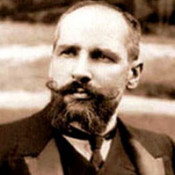
The Stolypin agrarian reform begins
On November 9 (22), 1906, on the initiative of the Ministers Council of Peter Arkadievitch Stolypin it was issued the decree on the order of peasants’ withdrawal from the community and the ownership of allotments that signified the beginning of the agrarian reform.
Under the imperial decree the peasants were given the right to own an allotment and to freely withdraw from the village community. Each householder had the opportunity not only withdraw from the community, but legally sell his allotment, or to obtain an equivalent plot instead of separate land strips, and to create on his allotment an isolated peasant farmstead.
The key factors of the reform were the works on the land management, the activity of the Peasant land bank and the resettlement policy of the government.
The reform had several objectives: create in the countryside a solid support for the monarchy among strong landowners by making them break with the bulk of the peasantry and by opposing them to it (strong farms had to become an obstacle for the revolution in the countryside); dissolve the community, implant private farmsteads and plots, and the excess of labor force direct to the cities where it would be absorbed by the growing industry; provide the rise of the agriculture and the further industrialization of the country in order to catch up with the arrears from the advanced states.
The main point of the Stolypin agrarian reform was to authorize all the peasants to freely withdraw from the community and legally make their allotments a heritable property abolishing the rest of the redemption money. It was intended that only applying economical methods landowners would be made to sell their land to peasants and give them the allotments from the state or other lands.
According to P.A. Stolypin, he needed 20 years of peace, without wars or revolutions, in order for his agrarian reform to succeed. “Provide 20 years of peace and you will not recognize Russia!” – said the reformer. But his expectations were not realized.
As a result of Stolypin death in September of 1911, the beginning of the First World War and the revolution that had broken out in the country, the reform was not completed. On June 28 (July 11), 1917 under the order of the Provisional government the Stolypin agrarian reform was stopped.
Lit.: Аврех А. Я. П. А. Столыпин и судьбы реформ в России. М., 1991; Костинский А., Орлова О. Столыпинская реформа: диктатура власти. 28.08.07 [Электронный ресурс] // Фонд изучения наследия П. А. Столыпина. 2008-2011. URL: http://www.stolypin.ru/news-publikacii/diktatura-prava; Островский И. В. П. А. Столыпин и его время. Новосибирск, 1992; Столыпинская аграрная реформа [Электронный ресурс] // Хронос. 2000. URL: http://www.hrono.info/sobyt/stolyp_ref.html; Тюкавкин В. Г. Великорусское крестьянство и столыпинская аграрная реформа. М., 2001.
Based on the Presidential Library’s materials:
Комитет по землеустроительным делам. Краткий очерк за десятилетие: 1906-1916. Петроград. 1916;
Премьер-министр П. А. Столыпин на прогулке [Изоматериал] : [фотография]. Киев, 1911;
Премьер-министр царского правительства П. А. Столыпин [Изоматериал] : [фотография]. СПб., 1911;

